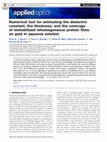Papers by Antonio M . N . Lima
Springer Series in Surface Sciences, 2019
Surface Plasmon Resonance Sensors, 2019
This chapter describe the operation points, i.e., the necessary parameters to excited the surface... more This chapter describe the operation points, i.e., the necessary parameters to excited the surface plasmon for the free electron type metals. Aspects like incident angle range, wavelength range, metal thickness, optical substrate, nanoparticle size, dynamic range, responsivity, SPR depth intensity and line broadening are present.
IECON 2016 - 42nd Annual Conference of the IEEE Industrial Electronics Society, 2016
This paper presents a control for universal active filters derived from the current-shaping contr... more This paper presents a control for universal active filters derived from the current-shaping control strategy previously employed for shunt active filters. It operates with a reduced number of sensors, using only two AC and one DC real time measurements. The proposed solution has natural mitigation capability for nonlinear loads, which can be further improved with a quasi-resonant scheme. The resulting nonlinear energy flow tracking is designed using a robust control framework, with guaranteed stability and optimal performance for a predefined range of operation. Experimental results are presented using a 1kVA prototype.
Surface Plasmon Resonance Sensors, 2019
2016 IEEE International Conference on Automatica (ICA-ACCA), 2016
Ventricular assist devices are mechanical blood pumps used to provide circulatory support in pati... more Ventricular assist devices are mechanical blood pumps used to provide circulatory support in patients waiting for a heart transplantation. In many cases, when the support lasts for months it may be advantageous to use a pump with a physiological control system to automatically adjust pump output in response to changes in the cardiovascular system (CVS). In this paper, we present a physiological controller for a pulsatile ventricular assist device (PVAD) that controls the device ejection volume considering the heart beat frequency. A mathematical model of the CVS based on analog electric circuits is used to analyze the cardiovascular response under ventricular assistance. The physiological controller is shown to be able to improve simulated hemodynamic conditions.
Research on Biomedical Engineering, 2016
Surface plasmon resonance biosensors are high sensitive analytical instruments that normally empl... more Surface plasmon resonance biosensors are high sensitive analytical instruments that normally employ glass materials at the optical substrate layer. However, the use of polymer-based substrates is increasing in the last years due to favorable features, like: disposability, ease to construction and low-cost design. Review: Recently, a polymer-based SPR biochip was proposed by using monochromatic and polychromatic input sources. Its construction and experimental considerations are detailed here. Experimental considerations and results, aspects from performance characteristics (resonance parameters, sensitivity and full width at half maximum-FWHM-calculations) are presented for hydrophilic and hydrophobic solutions. It is included also a brief description of the state of the art of polymer-based SPR biosensors.
SpringerBriefs in Physics, 2015
SpringerBriefs in Physics, 2015
This chapter describes the operation points, i.e., the necessary parameters to excite the surface... more This chapter describes the operation points, i.e., the necessary parameters to excite the surface plasmon for the free-electron type metals (Al, Li, and Mg). Aspects like incident angle range, wavelength range, metal thickness, optical substrate, nanoparticle size, dynamic range, responsivity, SPR depth, intensity and line broadening are present.
SpringerBriefs in Physics, 2015
This chapter describes the operation points, i.e., the necessary parameters to excite the surface... more This chapter describes the operation points, i.e., the necessary parameters to excite the surface plasmon for the classical noble metals (Cu, Au, and Ag). Aspects like incident angle range, wavelength range, metal thickness, optical substrate, nanoparticle size, dynamic range, responsivity, SPR depth, intensity and line broadening are present.
SpringerBriefs in Physics, 2015
Metal-Insulator multilayer structures (Ag-Al2O3-Ag) that exhibit a manifold of internal interface... more Metal-Insulator multilayer structures (Ag-Al2O3-Ag) that exhibit a manifold of internal interfaces are artificial materials, and also known as meta-materials. Their optical SPR properties are experimentally yet not explored.
2021 IEEE Energy Conversion Congress and Exposition (ECCE), 2021
This paper proposes a four-port AC/DC-DC/AC converter composed of a half-bridge converter and a f... more This paper proposes a four-port AC/DC-DC/AC converter composed of a half-bridge converter and a full-bridge converter replacing their inductive filters by means of a transformer. The power balance between the ports is achieved through both duty-cycles and the phase angle between the voltages applied by these bridges. The analysis of the converter was accomplished by using the superposition principle allowing to define different modes of operation. Furthermore, a control strategy is proposed for an application of the converter and in order to corroborate the theoretical analysis, simulation and experimental results are introduced. Finally, the performance of the converter is assessed as a function of the delivered power.
2018 IEEE International Instrumentation and Measurement Technology Conference (I2MTC), 2018
Micromachined flow sensors have appropriate features that allow the use for microfluidic systems ... more Micromachined flow sensors have appropriate features that allow the use for microfluidic systems in biosensors. Among these flow sensors, those based on the principle of thermal transfer are the most recently investigated. Here, a miniaturized sensor, which is based on the thermal anemometry, has been used to measure the flow velocity produced by a roller-based peristaltic mini-pump. The detection element consists of a heating element and a temperature monitoring element. Temperature compensation is achieved, and the instantaneous flow velocity is obtained from the sensor output voltage measurement. The sensor has been characterized and positioned in the normal direction to the flow. Eventually, the characteristic curve has been evaluated to provide an adequate control mechanism.
2021 4th International Conference on Bio-Engineering for Smart Technologies (BioSMART), 2021
This paper presents an in silico study on the use of graphene and molybdenum disulfide to increas... more This paper presents an in silico study on the use of graphene and molybdenum disulfide to increase sensor sensitivity. A multilayer structure in the Kretschmann configuration whose optically coupled substrate is a polymeric trapezoidal prism is used in angular interrogation mode to detect changes in the order of 0.002 in the analyte layer. The graphene monolayers deposition above the metallic film results in a significant increase in the sensitivity, reaching 8452.11 nm/RIU. However, despite being widely used to improve sensor responsiveness in some SPR sensor models, the addition of the molybdenum disulfide layer reduces the improvement resulting from the insertion of the graphene layers.
2020 IEEE Energy Conversion Congress and Exposition (ECCE), 2020
This paper presents a single-phase four-leg ac-dc-ac converter, with one leg shared by the grid s... more This paper presents a single-phase four-leg ac-dc-ac converter, with one leg shared by the grid side and the load side. The proposed topology can generate input and output voltages with seven levels, presenting reduced harmonic distortion, in addition to using reduced voltage switches. The space-vector pulsewidth modulation strategy (SV-PWM), the control technique, the system model, and a comparison with a three-leg topology will be presented. As for performance comparison parameters, harmonic distortion in currents and voltages, the average switching frequency, and semiconductor losses will be used. The topology was simulated and assembled in the laboratory to obtain experimental results.

IECON 2016 - 42nd Annual Conference of the IEEE Industrial Electronics Society, 2016
This paper presents some improvements over the previously presented current-shaping control for p... more This paper presents some improvements over the previously presented current-shaping control for parallel active filters. The proposed strategy allows the active filter to operate with a reduced number of sensors, and dependently of phase synchronization schemes for references generation. A new realization proposal employs a quasi-resonant system frequency adaptable to implement complex impedances, and have low interaction with harmonic components in the grid. An additional quasi-resonant scheme in a stationary reference frame is proposed to extend the current shaping control in order to achieve great mitigation capability. The energy flow control in this paper deals with further uncertainties, which results in an enhanced robust design methodology. Experimental results are presented using a 1kVA prototype.

2021 IEEE Energy Conversion Congress and Exposition (ECCE), 2021
This paper presents a nine-leg (9L) multilevel inverter to drive a six-phase induction machine in... more This paper presents a nine-leg (9L) multilevel inverter to drive a six-phase induction machine in an open-end winding (OEW) configuration. The system is based on three conventional two-level three-phase voltage source inverters (VSIs) and three, two, or one isolated dc links. A machine with two sets of 30 degrees shifted three-phase stator windings is considered. The inverter operating principles are discussed and a simple space-vector pulse-width modulation (SV-PWM) is proposed. The 9L-OEW system is compared with two conventional drives: the six-leg two-level (6L), and the 12-leg OEW (12L-OEW) systems. The number of components, the required dc-link voltage, voltage and current harmonic distortions, torque ripple, and semiconductor losses are considered as figures of merit. Simulations and experiments were also performed, showing steady-state results for a 1 HP machine operating at constant torque.
Surface Plasmon Resonance Sensors, 2019

Applied optics, Jan 20, 2018
A numerical simulation tool is reported for nanometer thin and inhomogeneous immobilized protein ... more A numerical simulation tool is reported for nanometer thin and inhomogeneous immobilized protein films on gold in aqueous solution. It allows for the first time, to the best of our knowledge, the simultaneous assessment of refractive index, film thickness, and surface coverage. The model relies on and combines the convective diffusion equation, the Langmuir adsorption isotherm, and the Helmholtz equation, with appropriate boundary conditions. These three differential equations were jointly solved using a multiphysics software. The physical film parameters were extracted employing an optimization procedure for immobilized bovine serum albumin, hemoglobin, and neutravidin films. The relatively good agreement between the extracted values for the refractive index, film thickness, and surface coverage and the corresponding values reported in the open literature show the correctness of the proposed methodology.

SpringerBriefs in Physics, 2015
The two sensing modes under consideration, the angular (AIM) and spectral (WIM) modes, exhibit ad... more The two sensing modes under consideration, the angular (AIM) and spectral (WIM) modes, exhibit advantages and disadvantages in terms of technical complexity, data processing and operating conditions. Schematics of the AIM and WIM optical set-up are shown in Fig. 3.1a, b, respectively. Each setup comprises a flat dove type prism chip. The design route allows the construction of compact instruments and avoids implementation of a bulky optical prism. The optical function of SPR prism chip is similar to a waveguide. In the AIM, incident radiation is a spectrally narrow band, while the angle range is wide and the resonance angle is recorded. In the WIM, the incident radiation is spectrally broadband, the incident angle range is narrow, comprising a collimated light beam, and a spectrometer tracks the resonance wavelength. A third-less popular-hybrid sensor configuration is the Intensity Mode (IM), as shown in Fig. 3.1c, where a collimated beam at a fixed (resonance) angle and wavelength is employed. The temperature coefficient of the refractive index of water at ambient T, with \(-1.2\times 10^{-4}\) RIU/\({^\circ }\)C, is quite high and exceeds those of the optical components, typically used in the optics design. Hence, it should be recalled that SPR sensors are particularly sensitive to temperature fluctuations. They are also sensitive to mechanical vibrations or thermal distortions in the optical path, down to the micrometer or even sub-micrometer levels. A rigid mechanical design is therefore beneficial. Surface conditions, preparation and functionalization, as well as long term temporal stability and signal drift effects are further important issues, since recordings may last for several hours.
SpringerBriefs in Physics, 2015
This chapter describes the operation points, i.e., the necessary parameters to excite the surface... more This chapter describes the operation points, i.e., the necessary parameters to excite the surface plasmon for other common metals (In, Sn, Zn, Pb, and Bi). Aspects like incident angle range, wavelength range, metal thickness, optical substrate, nanoparticle size, dynamic range, responsivity, SPR depth, intensity and line broadening are present.











Uploads
Papers by Antonio M . N . Lima